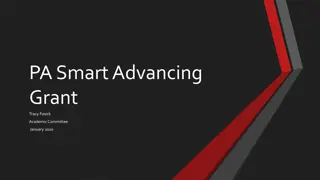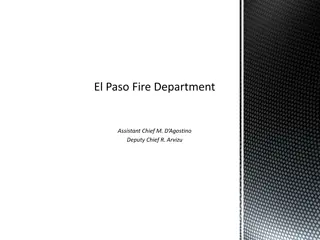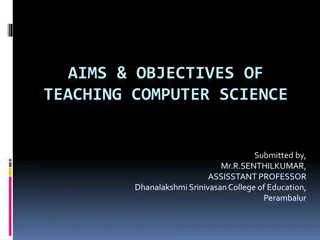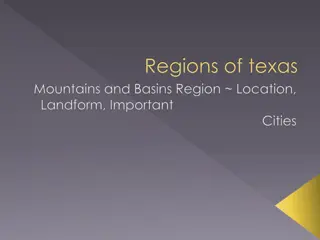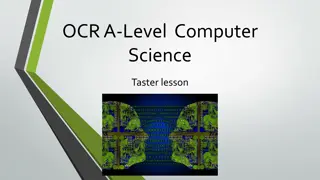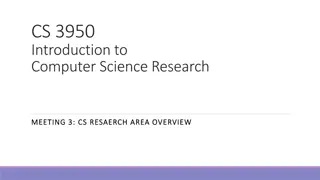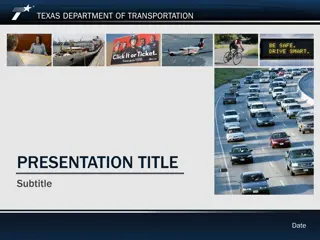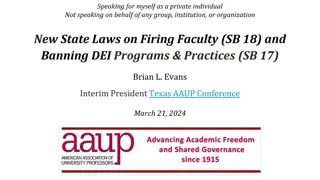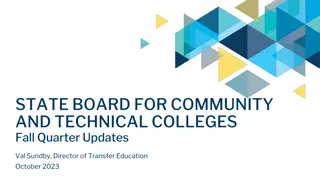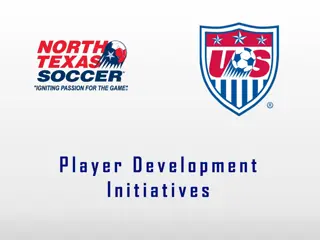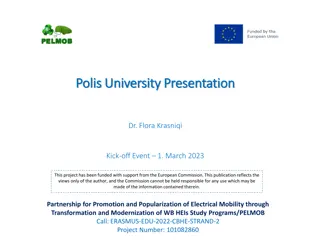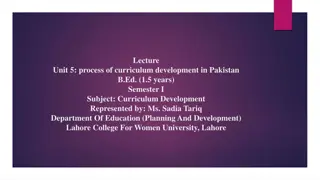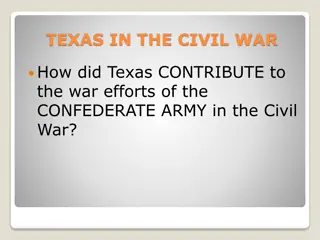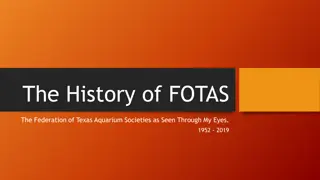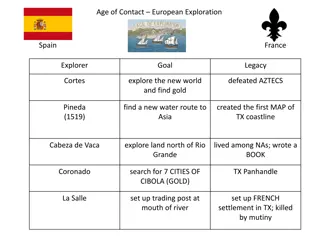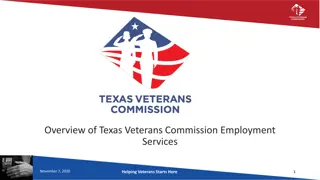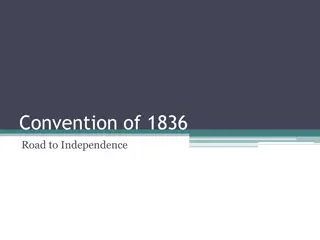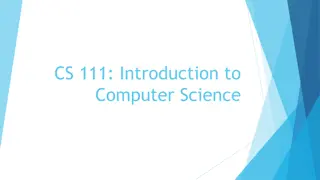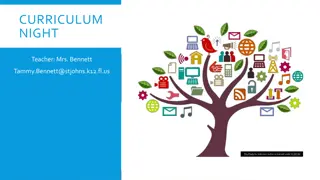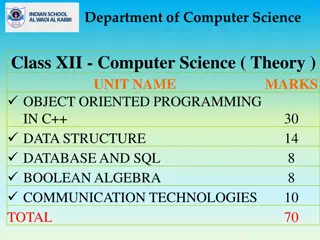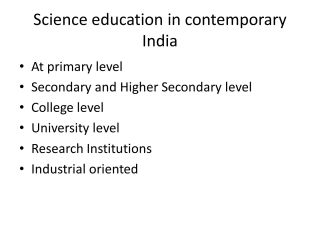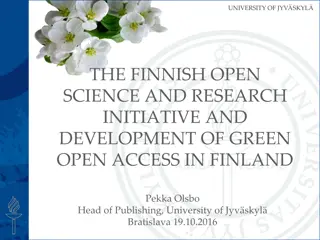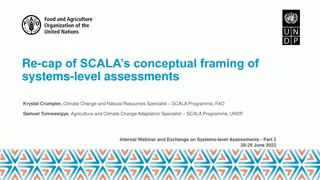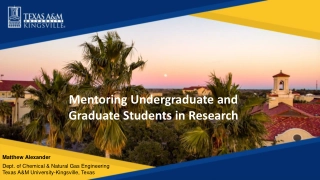Transformative Initiatives in Computer Science Education at the University of Texas at El Paso
Innovative programs led by Professor Ann Q. Gates at the University of Texas at El Paso are driving significant growth in undergraduate computer science education. Peer-Led Team Learning and other strategies have shown positive impacts on course completion rates, self-efficacy, and diversity in the field. These initiatives emphasize cooperative learning, enhance conceptual knowledge, and empower students to succeed in computing.
- Computer Science Education
- University of Texas at El Paso
- Innovative Initiatives
- Peer-Led Team Learning
- Diversity in STEM
Download Presentation

Please find below an Image/Link to download the presentation.
The content on the website is provided AS IS for your information and personal use only. It may not be sold, licensed, or shared on other websites without obtaining consent from the author. Download presentation by click this link. If you encounter any issues during the download, it is possible that the publisher has removed the file from their server.
E N D
Presentation Transcript
Ann Q. Gates THE UNIVERSITY OF TEXAS AT EL PASO Professor and Chair Director - CREST CyberShare Center of Excellence Director - CAHSI INCLUDES COMPUTER SCIENCE Martine Ceberio Professor
UNDERGRADUATE COMPUTER UNDERGRADUATE COMPUTER SCIENCE SCIENCE FIVE-YEAR GROWTH 2014-2018 934 934 839 839 479 479 408 408 309 309 2014 2015 2016 2017 2018
Support for Change Image result for Braid Harvey mudd image
Peer-Led Team Learning Undergraduate students lead near-peers in activities designed to enhance conceptual knowledge of course. Origins: (Dr. Gosser City College of New York, Chemistry education) CAHSI CAHSI adapted by incorporating cooperative learning elements o P Positive Interdependence o I Individual Accountability o G Group Processing o S Social Skills o F Face-to-Face Promotive Interaction
PLTL: Impact on PLTL: Impact on Hispanics and Hispanics and Women Women PLTL PLTL BEFORE BEFORE PLTL PLTL (n=4023) (n=4023) Percentage Percentage 74% 78% 80% Impact of PLTL on course Impact of PLTL on course completion rates completion rates AFTER AFTER PLTL PLTL (n=1172) (n=1172) Difference Difference (PLTL (PLTL Before) Before) Hispanic students showed significant increases in course completion after PLTL was implemented, x2(1, N=2716)=17.4, p<.01. GENDER FEMALE MALE NON- HISPANIC HISPANIC 87% 87% 84% 13% 9% 4% HISPANIC 86% 92% 6%
PLTL: PLTL: Self Self- -efficacy efficacy Students reported that PLTL increased their self-efficacy in computing (scale mean=7.93/10, S.D. 2.31, n=284) I was always worried that I don t know enough, or [there are] some programming strategies that I haven t quite gotten yet [but] I feel that I can really break a problem down into smaller steps and build my way up. And I think that s a good skill to learn for programming and I also think that I work well in groups. I know that in jobs you re always going to work in groups.
A comprehensive model Involves the deliberate design of research groups whose members share a common purpose an affinity Emphasizes the conscious development of students disciplinary knowledge, research abilities, and team skills Affinity Research Groups Creates and maintains dynamic, productive, and inclusive research groups. Provides a sense of professional identity and belonging.
An ARG is a non-hierarchical model that promotes: Collection of best practices Cooperative group interaction Deliberate and intentional development and practice of skills Support structures Expand participation by recruiting students who may not normally be involved in research
ARG: Benefits for Hispanic Students ARG: Benefits for Hispanic Students 87% of students reported that they were more likely to attend graduate school because of their ARG experience 87% of students reported that they were more likely to attend graduate school because of their ARG experience URSSA scales URSSA scales (4 (4- -point point scale) Hispanic Hispanic students students Means (S.D.) Means (S.D.) Non Non- -Hispanic students Hispanic students Means (S.D.) Means (S.D.) scale) Career and graduate school preparation ** 3.40 (.49) 3.09 (.65) Intellectual gains * 3.36 (.47) 3.11 (.46) Skills* 3.30 (.46) 3.06 (.53) **p<.01, *p<.05 ; independent samples t-tests Collaboration 3.36 (.39) 3.25 (.37) Personal growth 3.35 (.45) 3.27 (.48)
ARG: Entering the professional research ARG: Entering the professional research community community Professional Professional activity activity undertaken in the undertaken in the last year last year Number of out Number of out- - of of- -class ARG class ARG students students (n=143) (n=143) % % of ARG of ARG students students (n=143) (n=143) # of national # of national sample sample of research research students (NSF students (NSF REU) REU) (n=464) (n=464) % of national % of national sample sample (n=464) (n=464) of Attended a professional conference*** 88 62% 105 23% Authored or co- authored a journal article ** 18 13% 25 5% *** p<.001, **p<.01; independent samples t-tests Presented a conference paper or poster*** 54 38% 67 14%
Problem-solving courses Cybersecurity workshops Discrete Structures Introduction of 1- and 2-credit hour courses Reimagining CS Software Engineering Secure Software Systems Data Analytics Concentrations New courses to support minors and students who need to level NSF Grant 1042341 Introduction of new degree programs Re-imagining what it means to learn, whose knowledge counts, and what counts as knowledge.
CAHSI-GOOGLE PROBLEM SOLVING COURSES
Features Teaching Methods IDEAL framework Problem-Based Learning, a proven instructional model Active learning strategies mirroring problem solving of professionals Cognitive apprenticeship o Modeling o Coaching o Scaffolding I Identify the problem; D Define the problem by thinking about it and sorting relevant information; E Examine the options and potential solutions; A Act on a plan and strategies; L Look at the consequences and evaluate the effects of the activity.
CAHSI-Google Problem Solving Courses We're problem solvers, as computer scientists. And yet, it feels like we have stopped, or forgotten, or been too busy to make it more explicit in our regular (core) classes. The problem-solving course is our remedy. One of the biggest things that we have learned by running these classes is how... we're seeing big holes in our curriculum. This is forcing us to understand what students want to get out of our program we need to be more proactive to actually train them to do the stuff they need to do on the job. Faculty Reflections
Problem Solving as a Learning Environment Focused on Process Process Students in the spring 2019 survey cohort state that their problem-solving courses help them develop metacognitive skills. Specifically: Solve creatively Pose questions about the problem Explain HOW they solve problems more than 80% state often/almost always
Competitive Positions Microsoft MicrosoftHires Hires 10 interns in FY19 vs. 3 previous year.
One One- -Credit Hour Course Credit Hour Course Cyber Security Cyber Security Workshop Workshop- -style course introducing students to: style course introducing students to: Current software vulnerabilities Cyber operation techniques Defense and mitigation techniques Salamah Salamah* Salamah Salamah* Cybersecurity analysis tools 10 workshops in total including: 10 workshops in total including: Route hijacking Buffer overflow Android security Reverse engineering Digital forensics *Collaboration with ARL and industry *Collaboration with ARL and industry 18
Discrete Structures as a 1+2 Sequence Discrete Math used was a bottleneck in our curriculum Lack of genuine alignment and motivation for our CS students Split into a 1hr + 2 hrs sequence, offered along with CS1 and CS2
Emphasis on students prior knowledge Not from CS courses But from their own daily lives Use of physical props to practice CS concepts Focus on problem solving: Concepts White-boarding activities CS1 Redesign Meaningful labs Grading focused on acquisition of skills Encouragement of practice and growth Failure-safe environment
On-going CS2 redesign Focus on growth and skills Focus on problem solving Emphasis on extracurricular opportunities (such as internships) All while adjusting to growing enrollment
Faculty Brownbag Meetings Increase communication between faculty Increase collegiality Center conversations on students success Student success is always our concern Exchanging ideas on student success makes our efforts more efficient
Gauge student climate Classroom culture; access to resources Departmental experiences; involvement in opportunities Sense of community, identity and belonging; life demands Preparation for success Engage faculty in survey development & climate analysis DEPARTMENTAL CLIMATE Collaborate on development of student survey Analyze climate results through small group discussions Define actions to improvement Conduct workshops Audience: TAs, IAs, peer leaders, students, outreach leads Culture and identity Celebration of assets Relate curricular and co-curricular experiences to advantages
QUESTIONS agates@utep.edu mceberio@utep.edu




